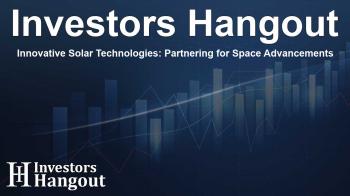Innovative Solar Technologies: Partnering for Space Advancements

Ascent Solar Technologies and NASA's Exciting Partnership
Ascent Solar Technologies (NASDAQ: ASTI) has reached a significant milestone in its quest to revolutionize space energy solutions. The company, which specializes in creating lightweight, flexible, and durable CIGS thin-film photovoltaic (PV) systems, has announced a groundbreaking collaboration with NASA's Marshall Space Flight Center (MSFC).
Advancing Spacecraft Power Solutions
The joint effort aims to develop next-generation spacecraft capable of receiving power transmitted via beamed energy, harnessing Ascent Solar's advanced CIGS PV modules. This initiative aligns perfectly with NASA’s ongoing mission to enhance operational capabilities in space while minimizing costs. Ascent's technology is positioned to provide a reliable source of power through microwave or laser beams directed from satellites or other orbital platforms, facilitating longer missions with less weight and complexity.
Current Innovations in Power Beaming
NASA has already made strides in this area, as demonstrated by the recently launched Psyche Mission, which utilizes beamed power to explore a unique metal-rich asteroid. The success of this mission and others has validated the effectiveness of tight-beaming technologies over expansive distances. The MSFC conducted tests this year, successfully receiving beamed power using Ascent's commercial-off-the-shelf products, paving the way for the current collaboration envisioned to last for one year.
Impactful Collaboration Goals
The core objective of their partnership is to streamline products and architectures that incorporate this cutting-edge technology. Ascent is committed to providing essential design and prototyping services, while NASA imparts technical expertise and testing capabilities. The endgame is to create commercial solutions that significantly reduce the cost, complexity, and risks associated with space missions.
Future-Proofing Space Exploration
As Paul Warley, CEO of Ascent Solar Technologies, noted, "This collaboration amplifies our belief that thin-film solar technology is key to solving the challenges of efficient solar energy conversion and beamed power reception in harsh space environments." Their concerted efforts aim to launch a product line that enhances efficiency and curtails mission expenses, placing Ascent firmly as a vital player in upcoming space explorations.
The Growing Market for Beamed Power
The rise of the beamed power market comes at a crucial time, with projections indicating it could evolve into a multi-billion dollar industry by the end of the decade. Increasing demands for renewable energy solutions alongside a global emphasis on sustainability have made space-based solar power highly sought after.
Testing Ascent's CIGS Modules
The collaboration will rigorously assess Ascent's ability to generate power from intense beams of light, focusing on maximizing usable power output comparable to a concentrated sunlight source. The potential to deliver ten times more power on demand, using the same PV cells, may notably decrease the size and weight of solar arrays, optimizing spacecraft design and function.
Reducing Downmass Effectively
Ascent's innovative approach seeks to alleviate downmass concerns that current spacecraft power systems face. With planetary missions often burdened by hefty subsystems, Ascent’s technology aims to slash the necessary mass and volume of power systems. The company estimates that its CIGS PV modules could yield savings worth millions on lander missions.
Catalyzing NASA's Missions
Ultimately, this collaboration will help assess whether Ascent's technology can enhance NASA's capacity to successfully execute its Commercial Lunar Payload Services (CLPS) missions, as well as advance objectives outlined in the Artemis campaign geared towards lunar exploration. The ability to power equipment in extreme environments and reach areas of scientific interest represents a leap forward for space exploration.
Driving Innovation in Space Exploration
With ongoing ambitions to venture further into the cosmos, Ascent Solar's partnership with NASA stands to play a pivotal role in future missions. By leveraging lightweight, flexible CIGS PV modules, NASA could significantly lower costs and disruptions while achieving its exploratory objectives more efficiently.
Frequently Asked Questions
What is the main goal of the collaboration between Ascent Solar and NASA?
The primary aim is to develop spacecraft capable of utilizing beamed power from Ascent Solar's advanced PV modules, enhancing mission viability and reducing costs.
How could Ascent's technology benefit space missions?
Ascent's technology allows for lightweight solar panels that can effectively collect energy from beamed sources, potentially resulting in longer missions with fewer resources.
What are the potential cost savings Ascent's CIGS modules offer?
Ascent estimates that its modules could lead to savings of tens of millions on individual lander missions by reducing downmass requirements.
How is NASA currently using power-beaming technology?
Nasa has successfully applied power beaming in its Psyche Mission and is exploring further applications in its lunar and planetary science efforts.
What is the projected market size for beamed power solutions?
The beamed power market is expected to evolve into a multi-billion dollar industry by 2030, driven by increasing demand for green energy.
About The Author
Contact Hannah Lewis privately here. Or send an email with ATTN: Hannah Lewis as the subject to contact@investorshangout.com.
About Investors Hangout
Investors Hangout is a leading online stock forum for financial discussion and learning, offering a wide range of free tools and resources. It draws in traders of all levels, who exchange market knowledge, investigate trading tactics, and keep an eye on industry developments in real time. Featuring financial articles, stock message boards, quotes, charts, company profiles, and live news updates. Through cooperative learning and a wealth of informational resources, it helps users from novices creating their first portfolios to experts honing their techniques. Join Investors Hangout today: https://investorshangout.com/
The content of this article is based on factual, publicly available information and does not represent legal, financial, or investment advice. Investors Hangout does not offer financial advice, and the author is not a licensed financial advisor. Consult a qualified advisor before making any financial or investment decisions based on this article. This article should not be considered advice to purchase, sell, or hold any securities or other investments. If any of the material provided here is inaccurate, please contact us for corrections.

